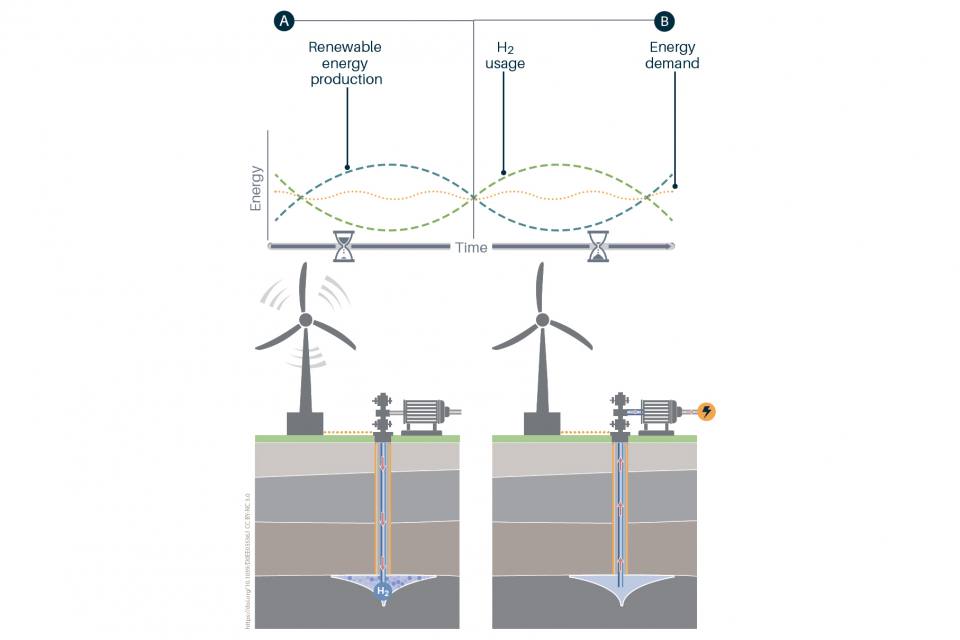Safe storage of hydrogen in porous rocks: the challenges and knowledge gaps
Increasing the amount of renewable energy that generates clean electricity will require a transition from natural gas to hydrogen and to store heat/cool in rocks.
12/02/2021 By BGS Press
The scale of carbon reduction, required for net zero, will require the implementation of swift and large-scale changes to how we generate and transport energy. One route to broad decarbonisation is to increase the amount of renewable energy that generates clean electricity. This pathway to clean energy will also require a transition from natural gas to hydrogen and to store heat/cool in rocks.

(A) Hydrogen is pumped underground and stored during periods of high renewable energy production. (B) On calm days, to satisfy demand during times of high energy demand and low renewable energy production, compressed hydrogen provides the energy to power gas turbines that generate electricity. BGS©UKRI; adapted from Enabling large-scale hydrogen storage in porous media – the scientific challenges (CC BY-NC 3.0)
New collaborative research by BGS highlights the scientific challenges of hydrogen storage in porous rocks for safe and efficient large-scale energy storage. Enabling large-scale hydrogen storage in porous media – the scientific challenges sets out the key global challenges and knowledge gaps in hydrogen storage. The study also highlights the urgent need for multidisciplinary research to address these gaps.
As part of the UK Government’s Ten Point Plan for a Green Industrial Revolution, £100 million will be provided for energy storage and flexibility innovation challenges. The expectations for energy storage are high, but large-scale underground hydrogen storage in porous rocks remains largely untested. For comparison, similar research into carbon dioxide storage capacity estimation has been ongoing since the 1990s, but carbon capture and storage (CCS) has yet to reach commercial scale in the UK.
To accelerate hydrogen supply on the scale required for net zero, it must be stored underground. BGS is addressing some of the technical challenges of storing hydrogen in porous rock formations by investing in an energy storage research programme.
Michelle Bentham, head of BGS Partnerships and Innovation
Background: underground energy storage
Energy can be stored in the subsurface at many locations in the UK, including offshore, in the following ways: :
- solution-mined caverns developed in halite (rock-salt) can be used to store:
- primary energy in the form of methane (a lower-carbon fossil fuel)
- hydrogen (which can supplement or replace existing natural gas as a feedstock to industry, or be used for domestic heating) can be produced by low-carbon/carbon-neutral methods
- compressed air, capturing and storing energy from wind and solar plants
- natural gas and possibly hydrogen can be stored in depleted hydrocarbon reservoirs
- heat/cool can be stored in aquifers and re-used as seasonal demand fluctuates throughout the year
Targeted BGS research programmes
To support greater uptake of these energy storage technologies, BGS is undertaking experiments designed to replicate repeated cycling of storage caverns to quantify deformation of bedded halite and to examine the response of sandstone properties to the presence of hydrogen. We will also use a borehole array, which has been specially designed to quantify the thermal response of different depositional facies of Permo-Triassic sandstone, at the UK Geoenergy Observatories to understand the thermal response of the sandstone and determine its suitability as a subsurface thermal store. Collectively, this work will:
- inform the development and behaviour of solution-mined caverns to act as storage facilities for methane, hydrogen and compressed air
- give a better understanding of the behaviour of hydrogen in the subsurface, especially changes to microbial populations and reservoir performance
- help us to quantify the thermal response and capacity of the Sherwood Sandstone, which is a major potential subsurface heat store that underlies many parts of the UK
The resulting work will indicate the potential and scale for subsurface energy storage across the UK and give important information to those interested in implementing new schemes to support the transition to a lower carbon world.

3D model of an engineered gas storage cavern that is solution-mined in halite. This cavern is over 500 m below the ground surface, with approximate dimensions of 80 m high, 50 m in diameter and 300 000 m3 in volume. BGS research has mapped out the areas where these caverns could potentially be developed. BGS©UKRI.
Addressing the UN Sustainable Development Goals (SDGs)

SDG 7: affordable and clean energy. Hydrogen is one of the most promising solutions to decarbonise gas networks, providing clean energy to homes and businesses.

SDG 9: industry innovation and infrastructure. Underground energy storage of hydrogen will contribute to a network of green energy infrastructure that will level out intermittent renewable energy production.

SDG 13: climate action. Replacing carbon-based energy sources with underground energy storage of hydrogen will help to reduce UK greenhouse gas emissions.
Project partners
This Energy & Environmental Science research paper was written as part of a GEO.8 collaboration.
- British Geological Survey
- German Research Centre for Geosciences (GFZ), Germany
- Geoplanet The Polish Geoscientific Network, Poland
- Institute of Earth Physics of Paris (IPGP), France
- Geosciences Barcelona (formerly Institute of Earth Sciences Jaume Almera), Spain
- Istituto Nazionale di Geofisica e Vulcanologia (INGV), Italy
- Swiss Federal Institute of Technology (ETH Zürich), Switzerland
- Utrecht University (UU), Netherlands
This web page uses some material adapted from the article Enabling large-scale hydrogen storage in porous media – the scientific challenges, published in Energy & Environmental Science by the Royal Society of Chemistry on 5 January 2021 under an open access Creative Commons CC BY-NC 3.0 licence. https://doi.org/10.1039/D0EE03536J
GEO.8 funded the workshop that led to the production of this paper.
Contact
Contact Michelle Bentham or visit Energy storage for more information.




